There was a time in the 1990s when only the most intrepid travellers made it to Bucharest.
Those days are truly in the past, and the city’s architectural beauty, its surfeit of high-quality museums and pulsating nightlife attract tourists from all walks of life.
In Bucharest you’ll discover firsthand just how a capital can absorb the body blows of war and totalitarianism, and still come back stronger.
Bucharest is flush with sophisticated parks and gardens, regal boulevards lined with palatial buildings and stylish bistros in high-ceilinged tenements.
Meanwhile the 20th-century monuments like the humungous Palace of the Parliament and absurdly pompous Bulevardul Unirii have an undeniable appeal.
1. Palace of the Parliament
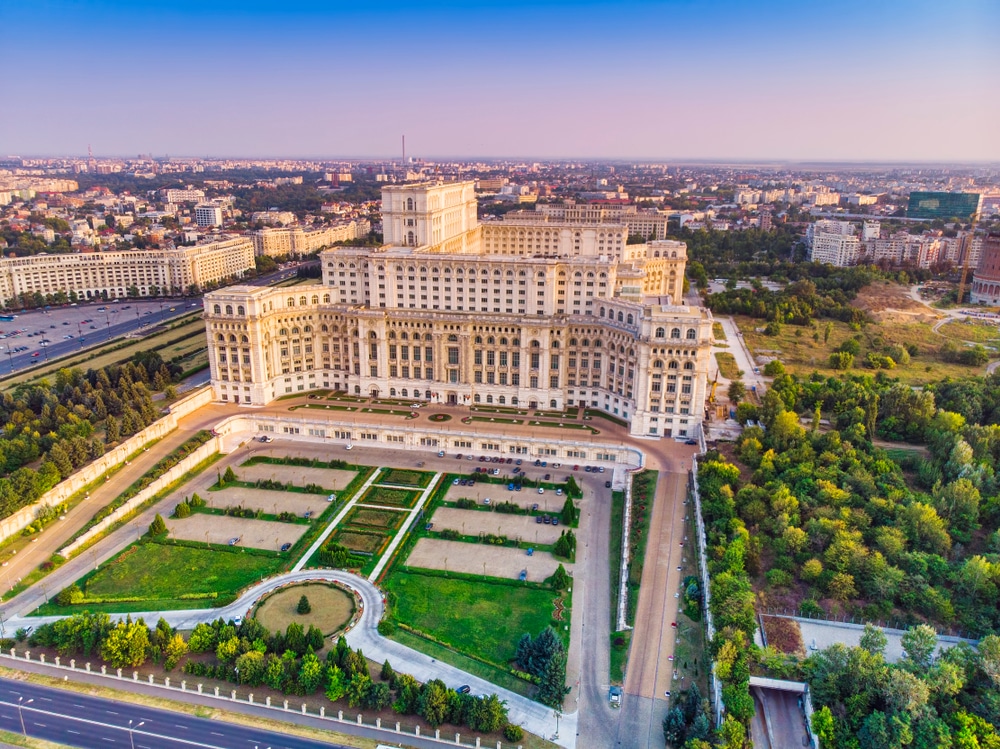 Source: Ioan Panaite / Shutterstock
Source: Ioan Panaite / ShutterstockIn the late-1970s, at the height of his cult of personality, dictator Nicolae Ceaușescu set about remodelling the centre of Bucharest in the style of Socialist Realism, like a European Pyongyang.
The centrepiece, at the western limit of his canyon-like Bulevardul Unirii, was the simply gargantuan Palace of the Parliament.
It’s impossible to convey the size of the Palace of Parliament, but among its claims to fame is that it’s the most expensive administrative building in the world ($3.4bn), the heaviest building in the world and the world’s largest administrative building.
Although it contains the Romanian Senate and Chamber of Deputies, the Palace of the Parliament is the ultimate white elephant, standing 70% empty.
And as an unavoidable reminder of an oppressive regime and the megalomania of Ceaușescu, it’s understandably a controversial monument.
But a landmark with this kind of significance needs to be seen up close, and there’s a choice of tours available.
As well as a standard tour, showing you around the extravagantly decorated halls, you can head up to the terrace for a panorama of Bucharest, or go deep underground into Ceaușescu’s cavernous nuclear bunker and learn about the system of catacombs under Bucharest’s streets, linking all of the main state institutions.
Website: http://cic.cdep.ro/en/
2. “Dimitrie Gusti” National Village Museum
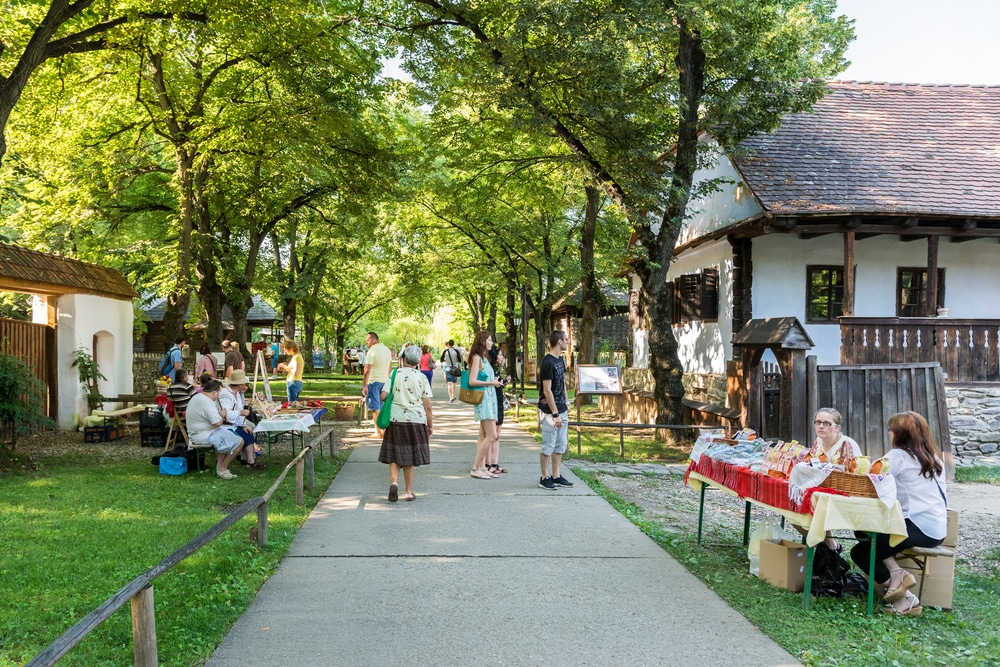 Source: Radu Bercan / Shutterstock
Source: Radu Bercan / ShutterstockThere’s an idyllic and enlightening glimpse of rural Romania at this outdoor museum on the west side of King Michael I Park.
With buildings and amenities collected from all of Romania’s provinces, the museum was established in 1936 at the behest of the folklorist and sociologist Dimitrie Gusti (1880-1955).
In peaceful wooded grounds you can amble past historic homesteads, churches, mills, wells, community ovens and more, all carefully relocated to this lakeside spot.
There’s a whole spectrum of vernacular architectural styles, adapting to Romania’s varying climates and soils, but also in some places the threat of invasion.
The village is made more authentic by an enormous collection of ethnographic objects, including ceramics, textiles, woodcarving, religious items, toys and costume, and it was on Gusti’s orders that every building is set up as it would appear in real life, and not as a museum piece.
Website: http://muzeul-satului.ro/en/
3. Romanian Athenaeum
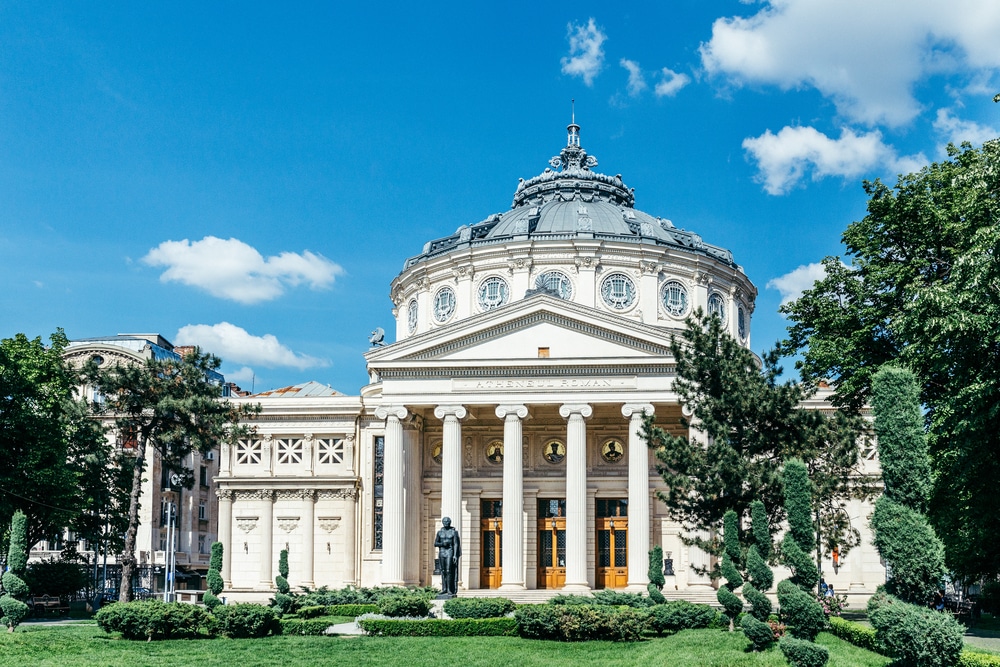 Source: Loredana Bitculescu / Shutterstock
Source: Loredana Bitculescu / ShutterstockConceived as a temple to Romanian, art, culture and science, this magnificent Neoclassical and Eclectic concert hall was constructed close to the Royal Palace in the 1880s.
Today the intimate and exquisitely decorated auditorium, with a capacity of 794, it’s the seat of the George Enescu Philharmonic Orchestra and lauded for its acoustics.
Naturally a concert is the best way to appreciate the Romanian Athenaeum, but if you come past on an ordinary day you have to take the opportunity to see the interior of Bucharest’s most beautiful monument.
The main reason is to view the Marea Frescă, a circular fresco on the frieze in the auditorium. Painted by Costin Petrescu, this piece is three metres high and 75 metres long and recalls some 1,800 years of Romanian history, beginning with the conquest of Dacia by Trajan.
4. National Museum of Art of Romania
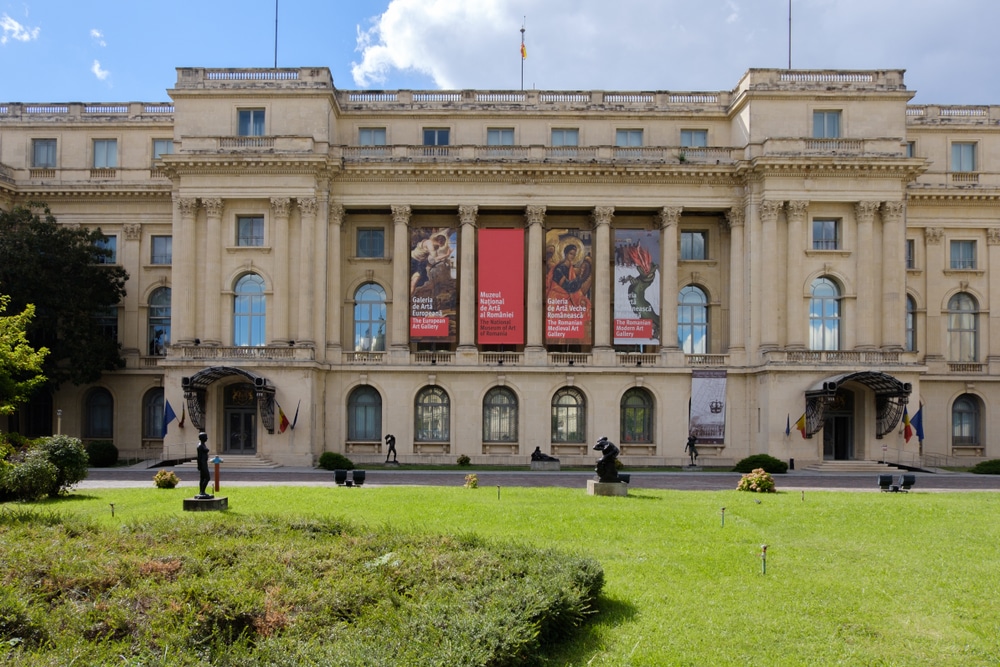 Source: FrimuFilms / Shutterstock
Source: FrimuFilms / ShutterstockWith a staggering assortment of Romanian and European art, this museum opened in 1948 at the Royal Palace on what is now Revolution Square.
The collection, running to more than 70,000 pieces, was assembled from royal properties around Romania, and a sizable portion belonged to Carol I of Romania (1839-1914).
The European Art Gallery presents painting, sculpture and decorative arts from the 1300s to the 1900s, with works by El Greco, Pieter Brueghel the Younger, Tintoretto, Hans von Aachen, Hans Memling, Lucas Cranach the Elder, Rubens, Courbet, Renoir, Monet, Signac and Pissarro.
At the Romanian Modern Art Gallery you can pore over pieces by Romania’s finest painters, Theodor Aman, Nicolae Grigorescu, Ion Andreescu and Gheorghe Petrașcu, to name a handful.
And finally, the first-rate Romanian Medieval Art Gallery has mostly religious icons, embroidery, vestments, liturgical items and frescoes recovered from historic churches and monasteries.
Website: https://www.mnar.arts.ro/en/
5. Old Town (Lipscani)
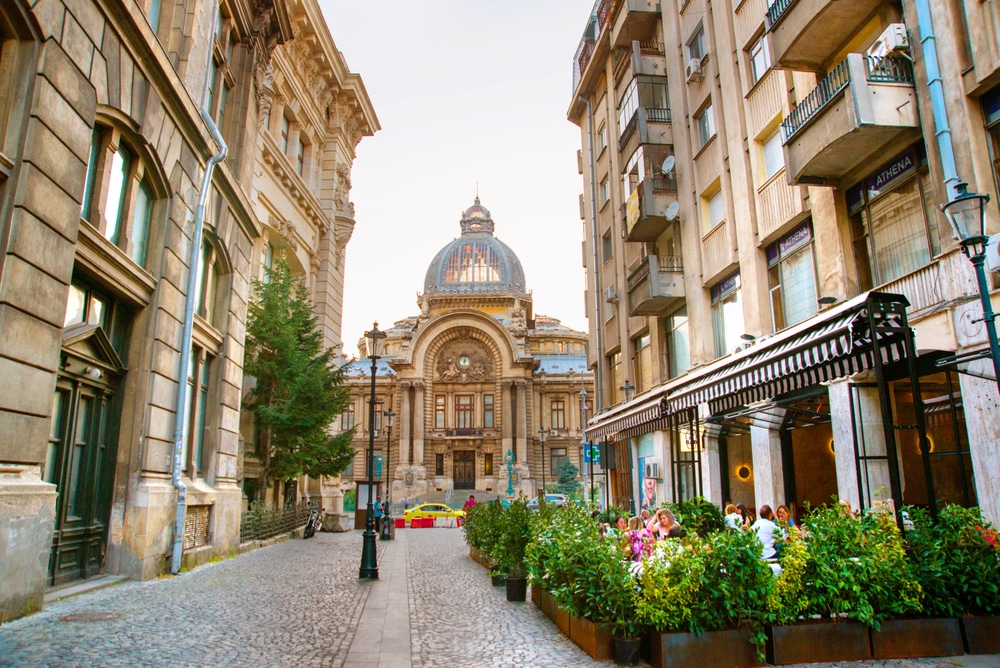 Source: Anna ART / Shutterstock
Source: Anna ART / ShutterstockAllied Bombing and the radical plans of Ceaușescu in the 70s and 80s levelled much of Bucharest’s history.
Despite all of the tumult of the last 100 years, much of the city’s pedestrian friendly core in Sector 3, dating back as far as the 1200s, has made it to the present day.
Over the last two decades this charming area, known for its beautiful but weathered 19th-century architecture, has become the place to go out in Bucharest, loaded with cafes, restaurants, bars and nightclubs.
The main artery is the cosy, cobblestone Lipscani, along which you’ll find some of the historic merchants’ inns that used to be scattered around the centre of Bucharest (see Hanul Cu Tei).
Hiding in the Old Town are plenty of interesting old monuments and archaeological sites, like the ruins of Vlad the Impaler’s Medieval royal court (Curtea Veche), found between Strada Covaci and Strada Franceză.
6. Cișmigiu Gardens
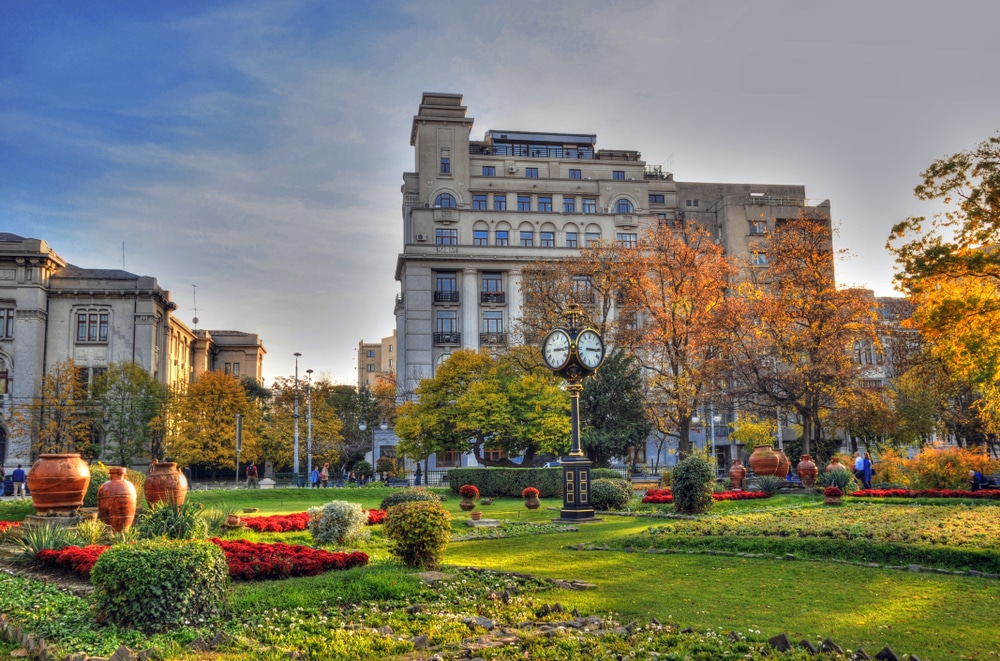 Source: The World in HDR / Shutterstock
Source: The World in HDR / ShutterstockThis elegant urban park, ever popular with young couples, was laid out in the middle of the 19th century, on what had previously been unhealthy swampy land connected to outbreaks of disease.
The man responsible for the initial design was German horticulturalist Wilhelm Meyer, who created a Romantic landscape .
Later the park was planted with walnut and chestnut trees from Dâmbovița and Gorj County respectively, as well as exotic plants cultivated at the Vienna Botanic Garden.
Cișmigiu Gardens is filled with mature trees, and the overhanging branches give ample shade to the peaceful alleys threading through it.
There’s a bandstand for concerts, children’s playgrounds, formal flower beds in the clearings and an ornamental lake snaking through the centre where you go boating in the summer.
One of the park’s alleys has a monument paying tribute to the French soldiers who died on Romanian soil in the First World War, while the Rotonda Scriitorilor is a circular walk lined with the busts of the 12 most important Romanian writers.
7. Museum of Art Collections
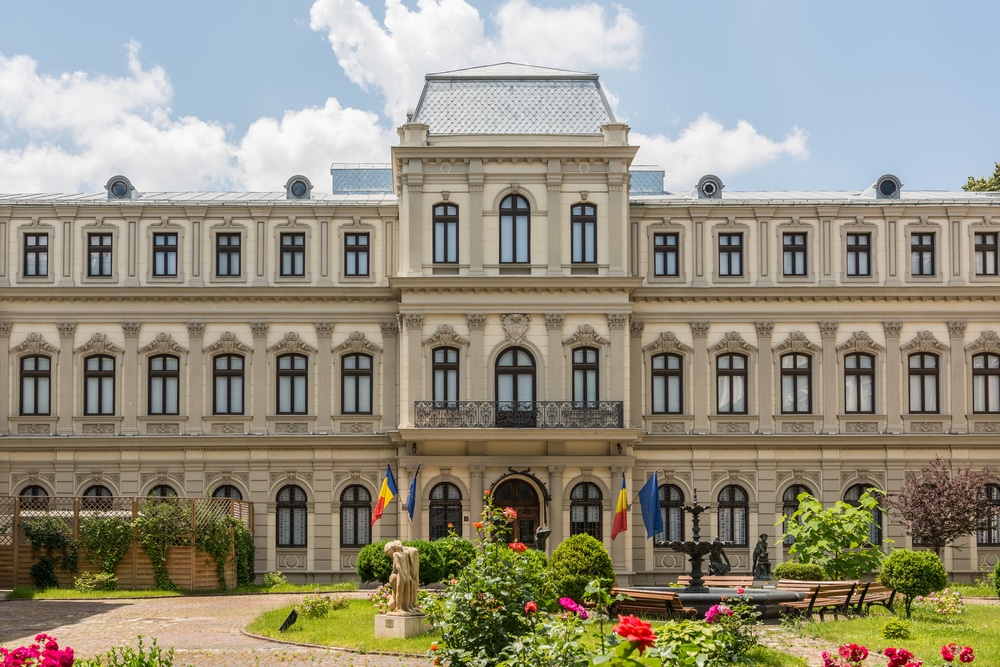 Source: Radu Bercan / Shutterstock
Source: Radu Bercan / ShutterstockA branch of the National Museum of Art, this gallery on Calea Victoriei is a showcase for the 40+ collection donations to the Romanian state by wealthy families since 1927.
All in the stately Romanit Palace, commissioned at the start of the 19th century by the boyar C. Faca, the Museum of Art Collections has a wide-ranging permanent exhibition, anchored by Romanian painting from the 19th and early-20th centuries.
A few of the artists with works on show are Nicolae Grigorescu, Theodor Aman, Ioan Andreescu, Theodor Pallady and Nicolae Tonitza.
Added to this are pieces by Western European artists, including a drawing by van Gogh, as well as Islamic and Asian art and Romanian sculpture in the museum’s lapidarium.
A poignant highlight here is the beautiful religious sculpture from the 18th-century Văcărești Monastery, demolished by Ceauşescu in 1986.
Website: https://www.mnar.arts.ro/en/museum-of-art-collections
8. National Museum of Romanian History
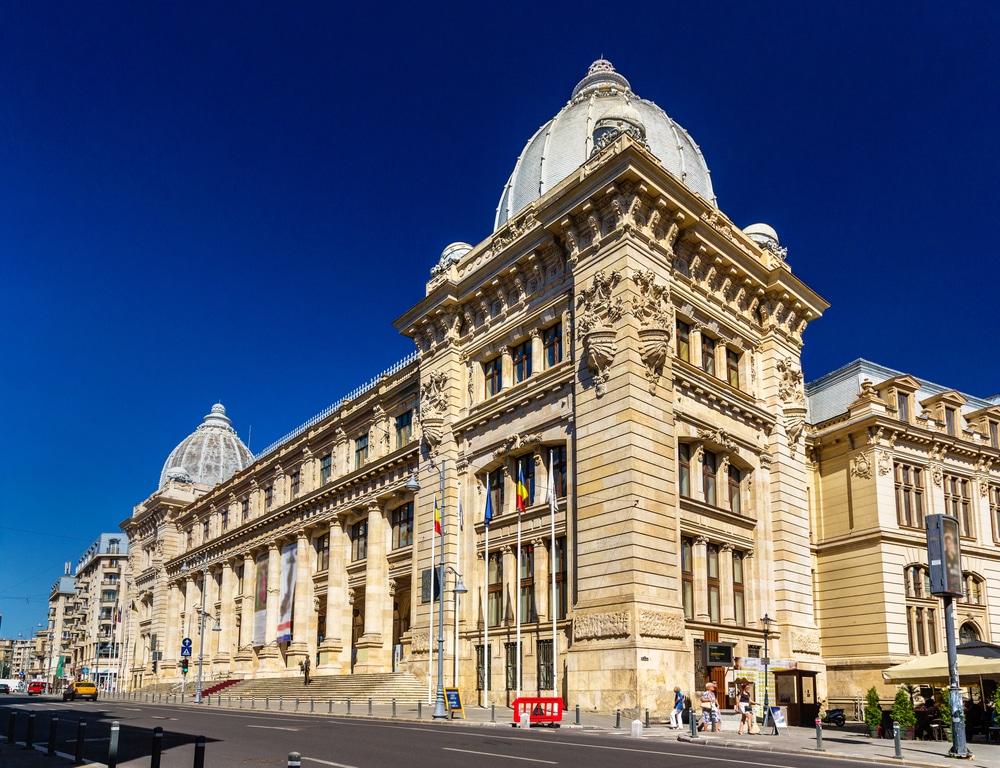 Source: Leonid Andronov / Shutterstock
Source: Leonid Andronov / ShutterstockRomania’s foremost museum for history and archaeology is on Calea Victoriei in the Eclectic Post Office Palace (1900).
The National Museum of Romanian History was set up here in 1970 and has a wealth of interesting things to see, going back to prehistory.
The Lapidarium is especially worth your time, presenting, among other things, a plaster cast copy of Trajan’s Column in Rome. This was made in the 1930 and allows you to view the reliefs, from the beginning of the 2nd century CE and celebrating Trajan’s conquest of Dacia, in perfect clarity.
Also fascinating is the museum’s large collection of hoards and treasures unearthed on Romanian soil.
These include spectacular Celtic and Dacian finds, but perhaps the most remarkable is the Gothic Pietroasele Treasure from the 4th century CE and famed for its large eagle-headed fibula.
The Romanian Crown Jewels are also here, including the crowns of Queens Elisabeta (1881) and Marie (1922), as well as exquisite Art Nouveau and Art Deco jewellery by Cartier and Lalique.
Website: https://www.mnir.ro/
9. Revolution Square
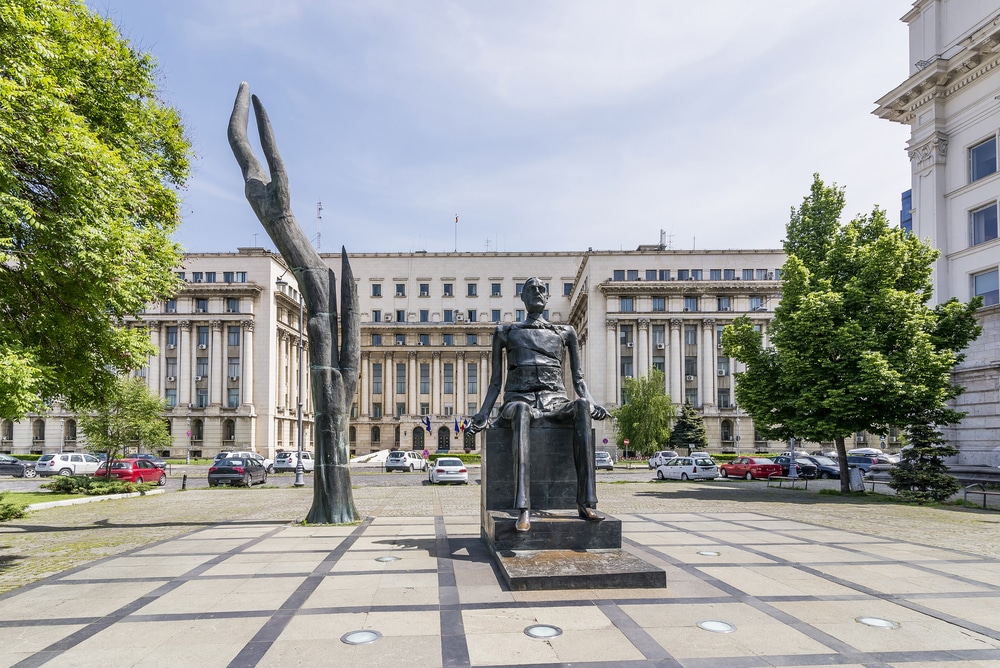 Source: Marco Taliani de Marchio / Shutterstock
Source: Marco Taliani de Marchio / ShutterstockThis plaza is bordered by several of the spots on this list, like the Romanian Athenaeum and the National Museum of Art.
One of the defining moments in the Romanian Revolution and the country’s modern history played out in this square on 21 December.
In an attempt to allay an uprising, Nicolae Ceaușescu gave a televised speech from the balcony of the Central Committee building. In 1968 this had been the scene for a speech condemning the Warsaw Pact’s invasion of Czechoslovakia, and marked the high point of his regime.
But 20 years later, the workers who had been bussed in for the speech, started openly expressing their discontent, and Ceaușescu’s astonished reaction, captured on camera, is one of the abiding images of the fall of communism in Eastern Europe.
The square was later renamed for the Revolution, and the building, largely unchanged, is now used by the Ministry of Internal Affairs.
Democracy came at a cost of some 1,500 lives, remembered by the Memorial of Rebirth at the centre of the square, erected in 2005.
10. Cotroceni Museum
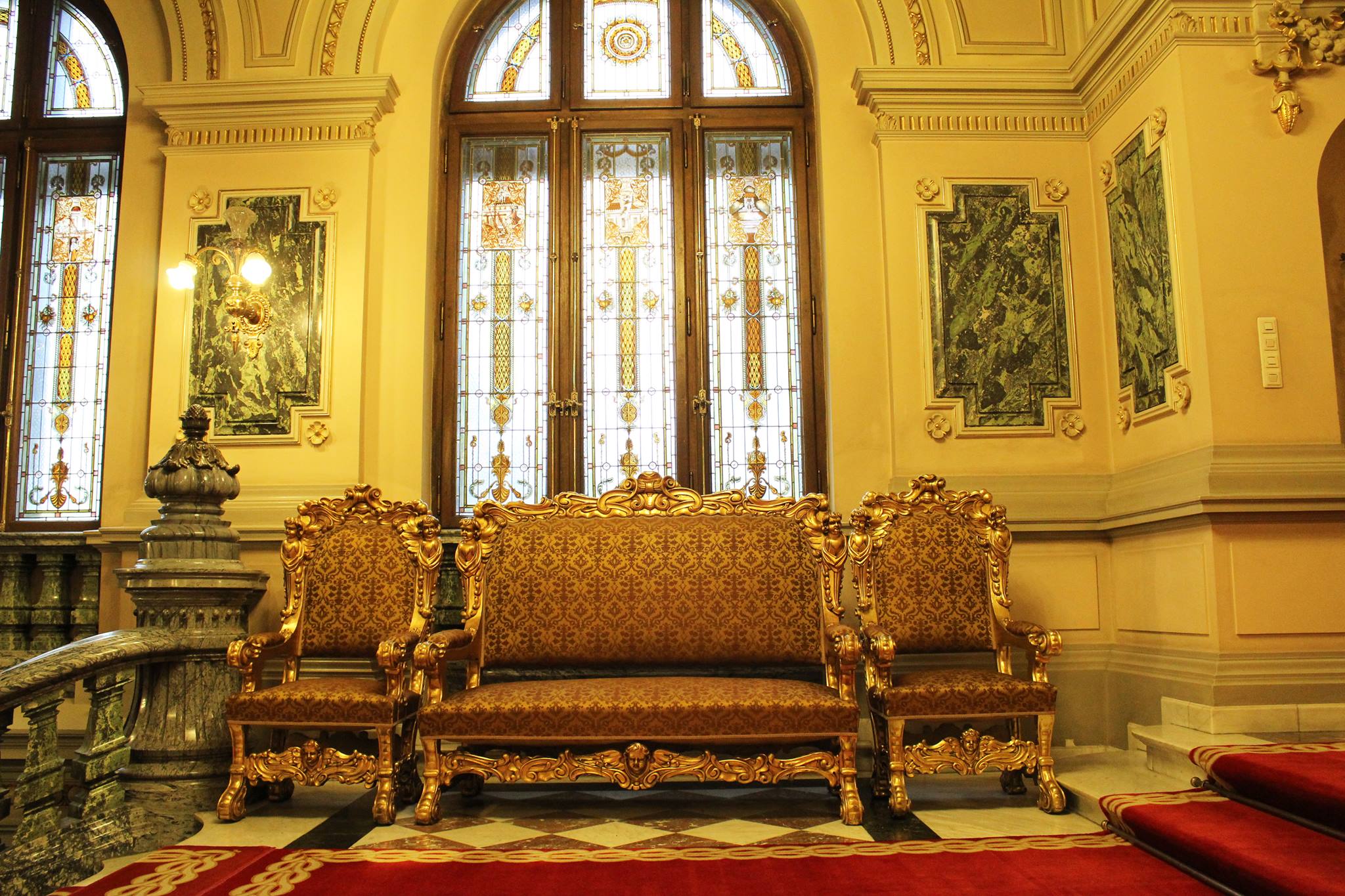 Source: Facebook.com
Source: Facebook.comWhat was previously a monastery founded to the west of Bucharest in 1679 became a favoured summer residence for Romania’s rulers.
Not long after Carol I of Romania inherited the property in 1883 he set about building a more luxurious neo-Baroque residence and commissioned French architect Paul Gottereau.
This exquisite palace came under the control of the Ministry of the Interior during the communist period, during which some of its art and decor were stripped.
In 1991 the Cotroceni Palace became the main residence of the President of Romania, while the older, restored sections were opened to the public as the Cotroceni Museum.
There’s a great deal of finery to take in on a pre-booked tour (two days in advance), as you make your way through the Hall of Honour, German Living Room, Hunting Room, Flowers’ Room, Library, Great Hall of Receptions, Royal Dining Room and the private apartments of the royal family.
A lot of the exquisite decorative art on show is from the private collection of Marie of Romania (1875-1938), the British wife of Carol’s heir Ferdinand I (1865-1927).
Website: http://www.muzeulcotroceni.ro/index_eng.html
11. Mogoşoaia Palace
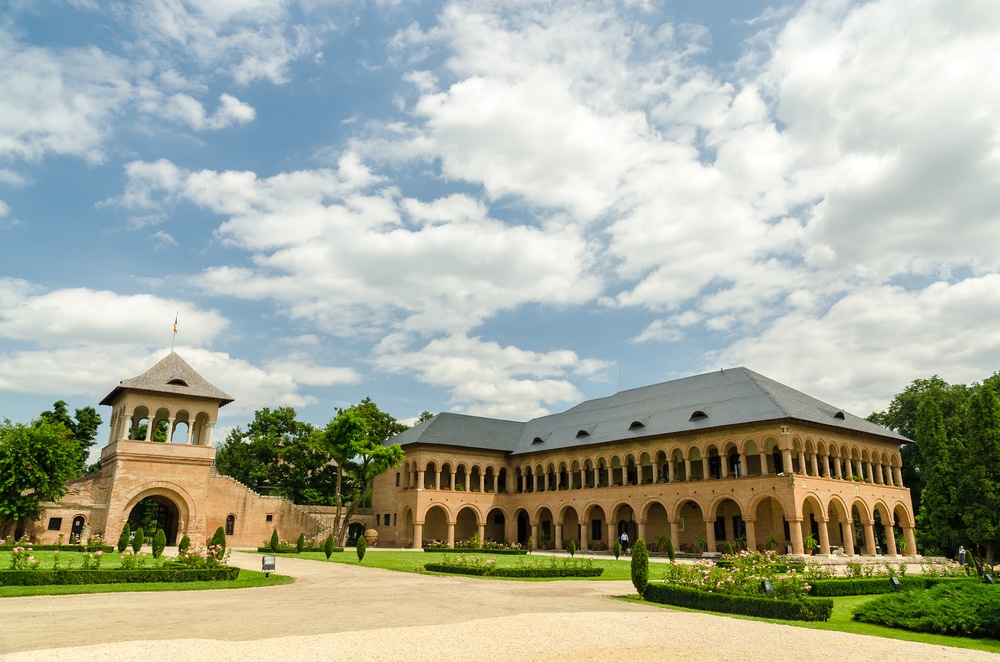 Source: Radu Bercan / Shutterstock
Source: Radu Bercan / ShutterstockFor a little rural interlude during your time Bucharest, you can escape to this estate about ten kilometres north-west of the city.
Set in woodland by the lake of the same name, Mogoşoaia Palace was built at the turn of the 18th century by the Prince of Wallachia, Constantin Brâncoveanu, in the Brâncovenesc style that was named after him, melding Byzantine with Renaissance and Baroque elements.
The property is a popular day out with Bucharest residents and tourists, to wander the formal gardens, go for bike rides and take picnics by the lake.
The palace has housed a museum since 1957, and this displays a mix of contemporary art and items belonging to the Bibescu family, who descended from Brâncoveanu.
Their family vault, including aviation pioneer George Bibescu (1880-1941) can be found at the Mogoşoaia Church, located on the palace grounds and dating to 1688.
12. King Michael I Park
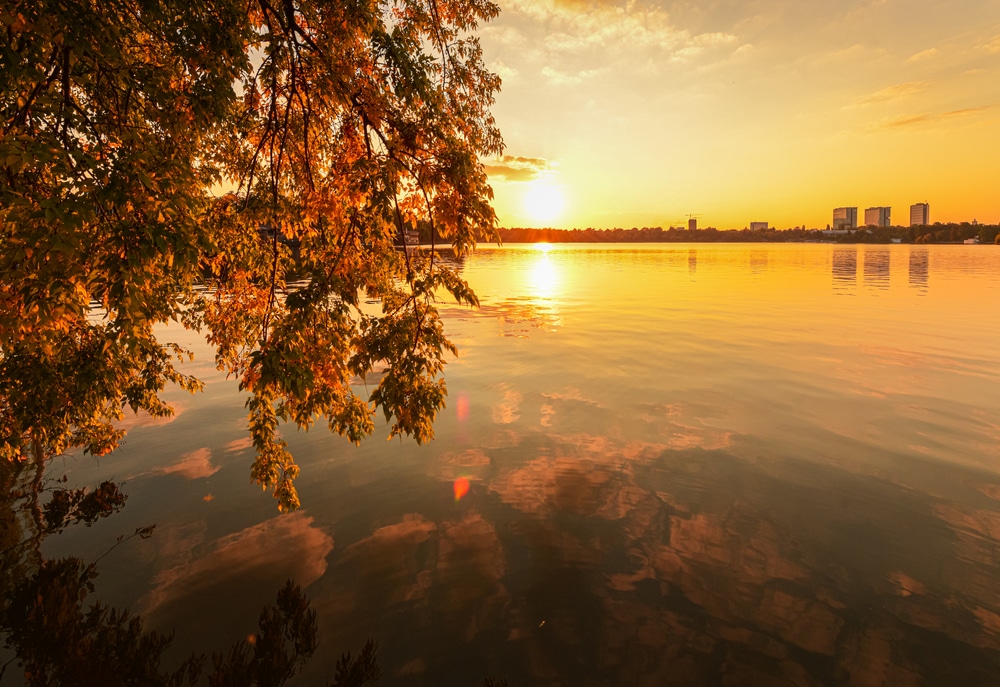 Source: Dragos Asaftei / Shutterstock
Source: Dragos Asaftei / ShutterstockAfter visiting the Village Museum you can head off to explore the surrounding park, the largest in Bucharest.
This is a 187-hectare sweep of blissful greenery, containing the large Lake Herăstră on the Colentina River.
Away from the Village Museum, the park hums with activity as one of the capitals favoured places for outdoor recreation.
In summer, you can hire a boat and see where your curiosity takes you on the lake, while a must-see in spring is the Japanese garden with its blooming cherry trees donated by the Emperor of Japan.
Much of the park is deciduous, planted with willows, poplars, ashes, lime trees and maples, so later in the year the autumn foliage is impossibly pretty.
The park is streaked with alleys, and there’s a path surrounding the lake, just under six kilometres in length. It’s a good idea to hire a bike for this trip, and on your ride you can recharge at one of the string of restaurants and cafes on the shore.
13. House of Ceauşescu
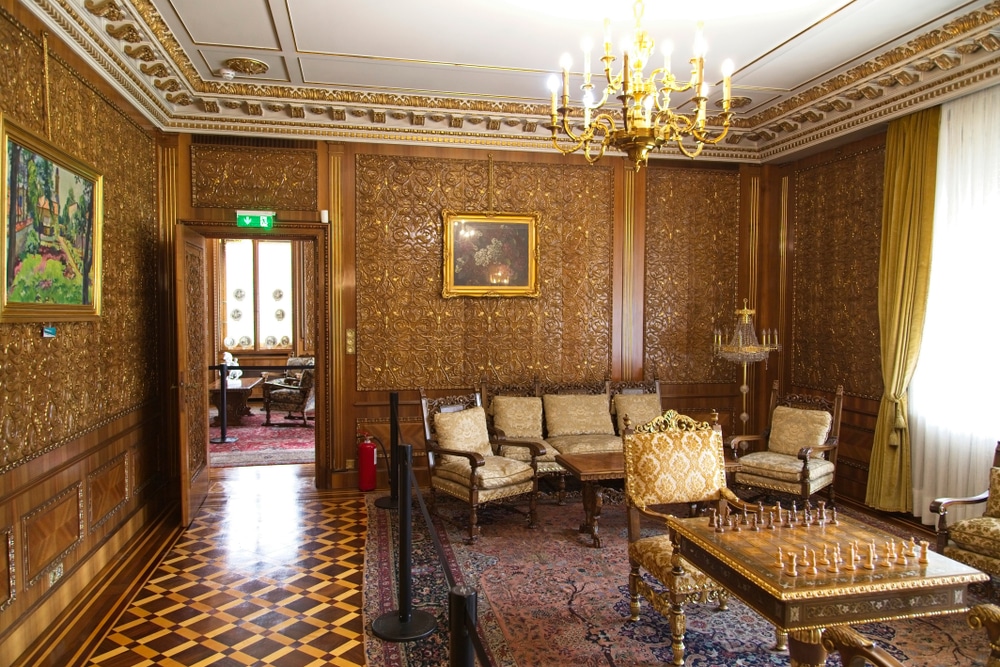 Source: Kevin Tietz / Shutterstock
Source: Kevin Tietz / ShutterstockFor 25 years until their downfall Nicolae and Elena Ceauşescu resided at this plush 80-room mansion just east of King Michael I Park.
A compelling historical document, the House of Ceauşescu can be visited on a guided tour, for rare insights into the private life of a man who defined the second half of the 20th century in Romania.
The property was built in 1965 and enlarged a few years later, and unsurprisingly has a high level of luxury.
This is obvious in the interiors’ gaudy but sophisticated wooden ornamentation, fashioned from native oak, sycamore, cherry and walnut, but also exotic rosewood, mahogany, Canadian cherry and African pear.
There’s also a wealth of art inside, from hand-crafted mosaics and tapestries to paintings by leading Romanian artists like Octav Băncilă, Rudolf Cumpăna and Camil Ressu.
Website: https://casaceausescu.ro/?page_id=3403&lang=en
14. Stavropoleos Monastery Church
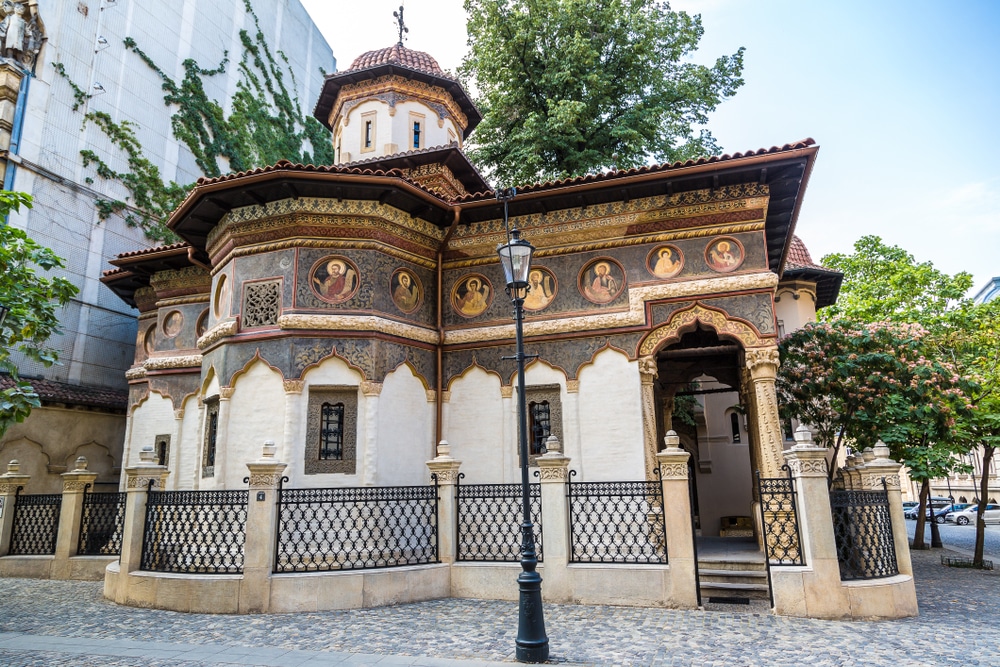 Source: S-F / Shutterstock
Source: S-F / ShutterstockA wonderful example of the Brâncovenesc style, blending Byzantine with Renaissance and Baroque architecture, this monastic church was built in 1724 by the Greek monk Ioannikios Stratonikeas.
The attached convent, now reinstated, was suppressed during the communist period, is renowned for its choir and neo-Byzantine music heritage, as well as for having the largest library of Byzantine books in Romania.
Go in to savour the church’s iconostasis, chandeliers and vibrant 18th-century frescoes on almost every surface.
The cloisters are also lovely, and decorated with historic and beautifully carved ledger stones. The 20th-century monastery building next door also merits a look, preserving liturgical objects, icons and fragments of frescoes recovered from the many churches destroyed during the Ceauşescu regime.
15. Antipa Museum
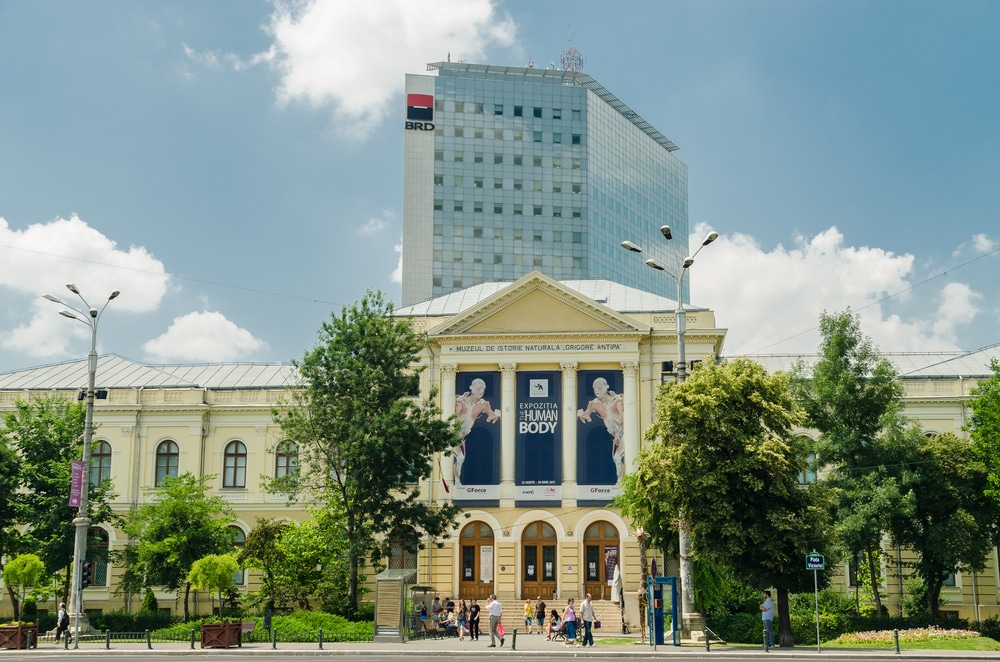 Source: Radu Bercan / Shutterstock
Source: Radu Bercan / ShutterstockRomania’s natural history museum is named for the celebrated naturalist Grigore Antipa (1866-1944) renowned for his studies on the fauna of the Black Sea and Danube Delta.
Under Antipa’s guidance the institution moved into its purpose-built, Neoclassical home on Şoseaua Kiseleff in 1908, and the entire museum was given an update around a decade ago.
There’s now a lot of multimedia and interactivity to go with historic taxidermies, ethnographic artefacts, fossils and minerals.
The basement deals with the biodiversity of Romania, broadening to ecosystems around the world on the ground floor. The first floor is packed with antique showcases covering everything from entomology to prehistoric humans, and these have been brought into the 21st century with multilingual audio commentary.
16. Cărturești Carusel
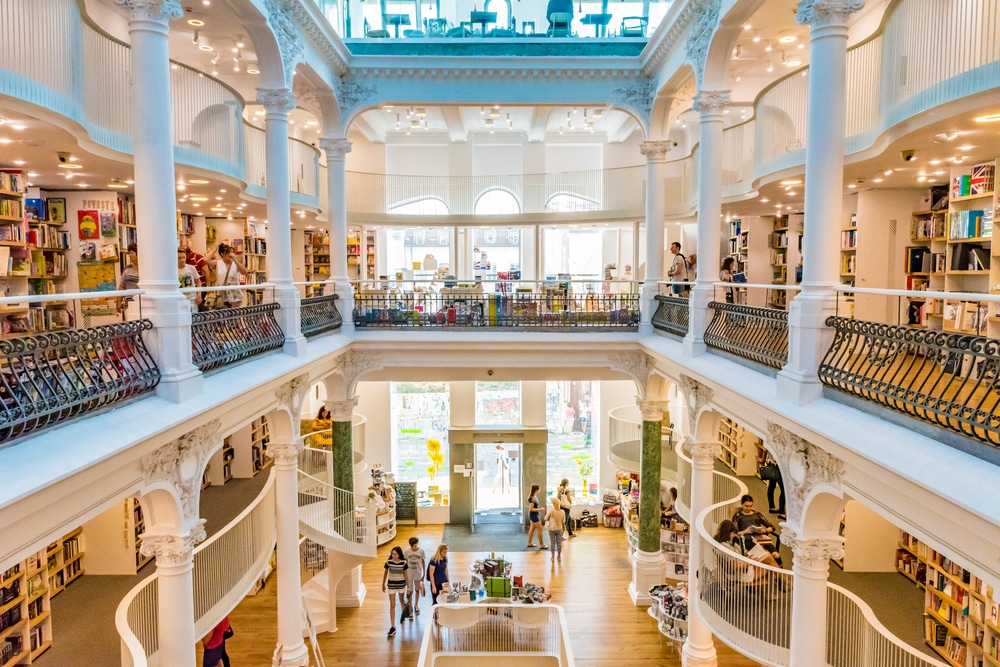 Source: Takashi Images / Shutterstock
Source: Takashi Images / ShutterstockIn the running for the most beautiful bookshops in the world, Cărturești Carusel on Lipscani (N. 55) is run by the Romanian chain, Cărturești and housed in a converted 19th century building.
This six-storey edifice came into the hands of the Chrissoveloni banking family in 1903, but was confiscated after the war and turned into the communist “Familia” store.
Cărturești Carusel opened in 2015 after a five-year restoration and conversion project.
The whole whitewashed interior is bathed in light from the atrium, framed by pillars with Composite capitals and dainty foliate decoration and cartouches above.
There’s a multimedia area in the basement, an exhibition space on the first floor and a bistro on the top floor.
17. Romanian Peasant Museum
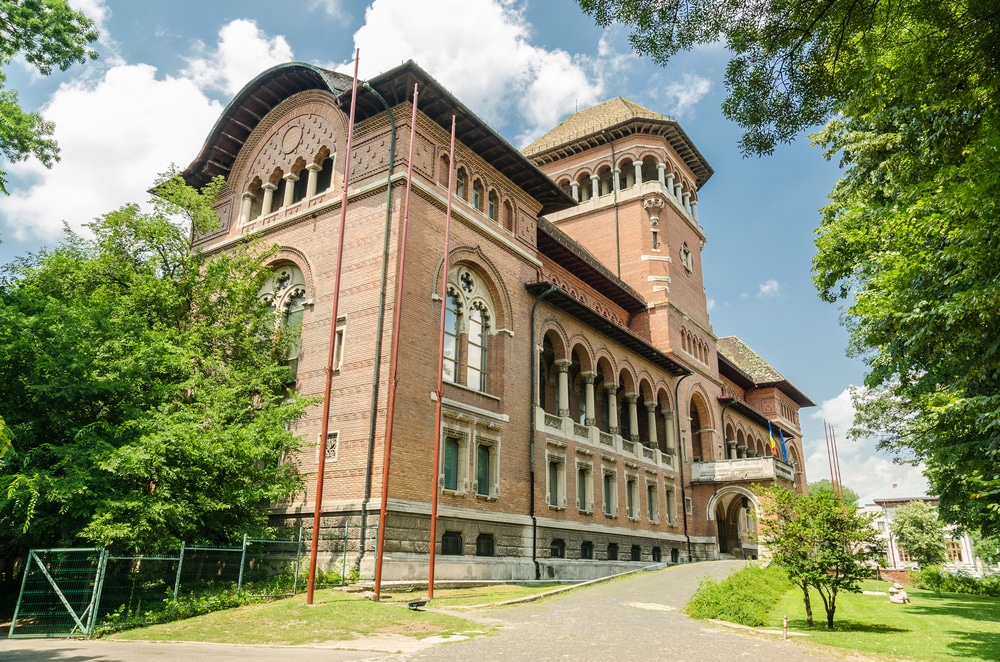 Source: Radu Bercan / Shutterstock
Source: Radu Bercan / ShutterstockEstablished in 1906, this ethnographical museum has an impressive display of Romanian folk art, going back as far as the 18th century.
You can check out folk costumes, woodcarving, furniture, ironware, religious objects and decorative fabrics, while in the museum’s courtyard you’ll find a wooden church from the 1700s.
The Romanian Peasant Museum stands out most of all for its ceramics, with some 18,000 pieces representing the country’s 200-odd pottery centre, including the entire inventory for some workshops in Hunedoara and Vâlcea.
In a Neo-Romanian building inspired by Byzantine monasteries, the Romanian Peasant Museum spent the period under Ceaușescu as a museum to communism, re-opening in 1990, just six weeks after his execution.
Website: http://www.muzeultaranuluiroman.ro/home.html
18. Therme Bucharest
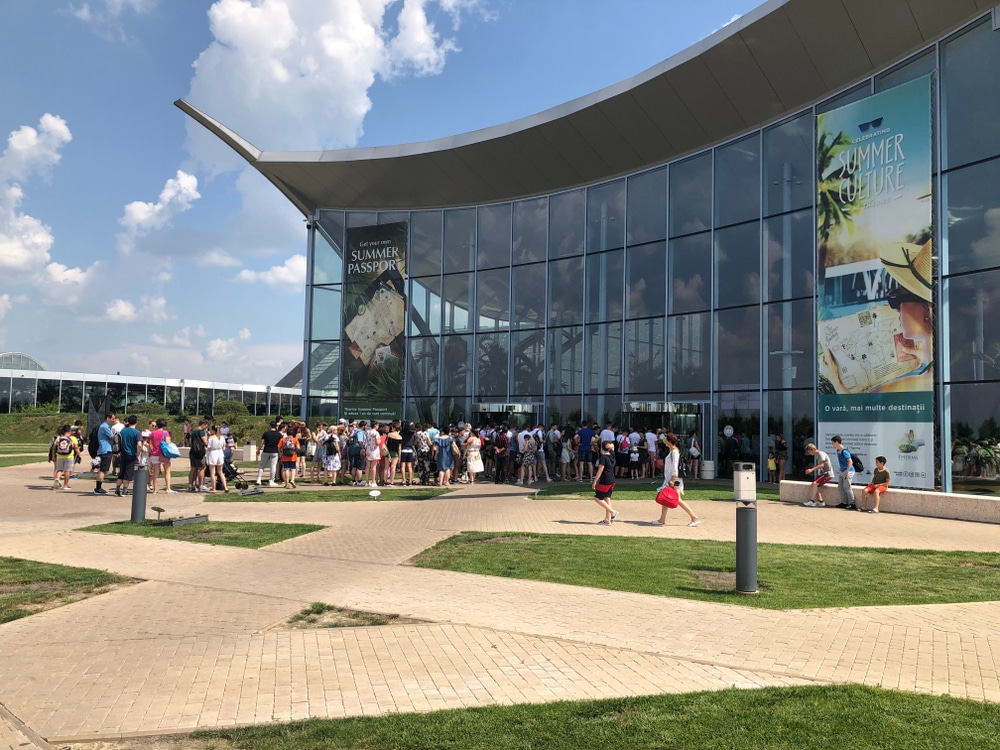 Source: Cosmin Placinta / Shutterstock
Source: Cosmin Placinta / ShutterstockServed by a shuttle bus, Europe’s largest spa complex is on Bucharest’s northern outskirts and opened in 2016.
Therme Bucharest quickly became the country’s most popular attraction, drawing more than 1.2 million visitors in its first year.
Open 365 days a year, the spa is nested in what is Romania’s largest botanical garden, growing 800,000 plants, among them 1,500 palms.
Greeting you here are ten pools (indoor and outdoor), six saunas and four steam rooms. The spring water in the pools is a constant 33°C and is sourced from a depth of 3,000 metres.
And while grownups can indulge in a bit of relaxation, there’s a waterpark for kids, with no fewer than 16 slides.
Website: https://therme.ro/en/
19. Kretzulescu Church
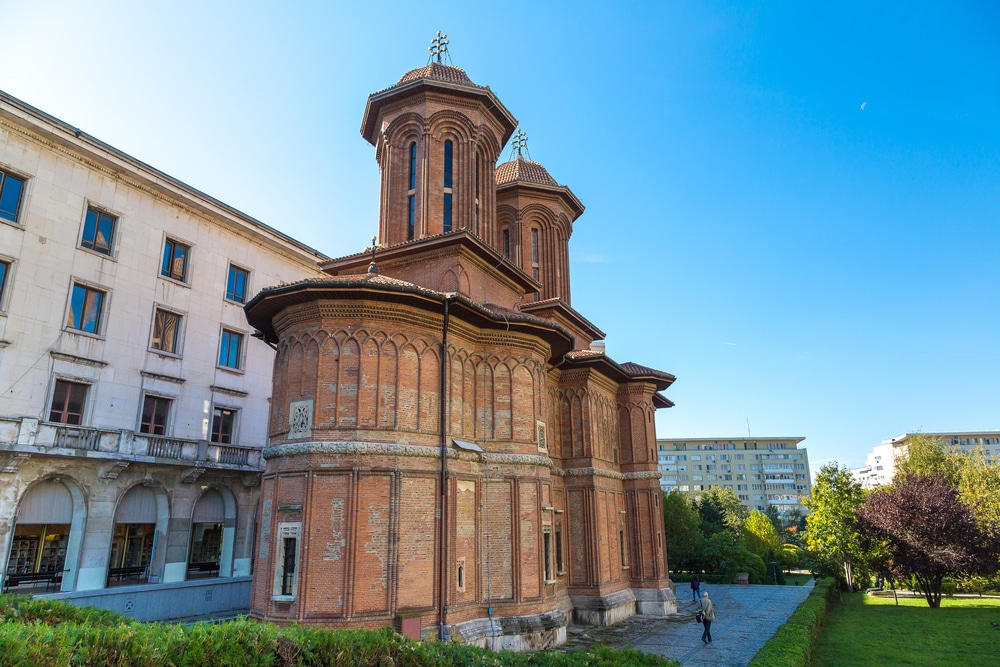 Source: S-F / Shutterstock
Source: S-F / ShutterstockJust off the south-west corner of Revolution Square is a fine church from the early-1720s, designed in the Brâncovenesc style, which peaked around this time.
The church was commissioned by the boyar Iordache Crețulescu, whose wife Safta was daughter of Prince of Wallachia, Constantin Brâncoveanu.
In the porch, fronted by an arcade, you can admire frescoes dating from the church’s construction.
The frescoes in the nave and apse meanwhile were painted in 1859-60 by Neoclassical artist Gheorghe Tattarescu (1818-1894).
The building was threatened with demolition in the communist period but was saved after appeals by architects, and was renovated in the late-70s and immediately after the Revolution of 1989.
20. George Enescu Museum
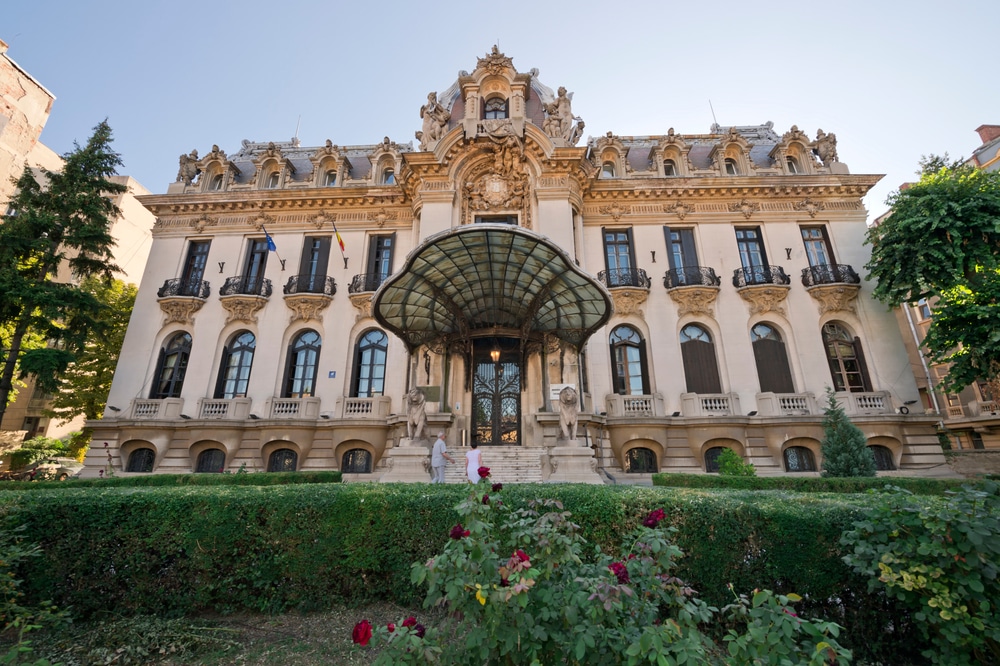 Source: Liviu Gherman / Shutterstock
Source: Liviu Gherman / ShutterstockAt this attraction on Calea Victoriei you can set foot inside one of the loveliest properties from Belle Époque Bucharest.
This is the Cantacuzino Palace, which went up between 1901 and 1903 for Bucharest mayor Gheorghe Grigore Cantacuzino.
His son Mihail, who inherited this sublime Art Nouveau mansion, died young, and Mihail’s widow married George Enescu (1881-1955), remembered as Romania’s greatest composer.
The museum in his honour is arranged in three exquisitely decorated rooms, rich with stained glass, chandeliers, frescoes and custom-made light fittings.
The exhibition charts Enescu’s career with manuscripts, musical instruments, photographs, documents and personal items relating to his life and work.
Website: https://www.georgeenescu.ro/en/
21. Romanian Patriarchal Cathedral
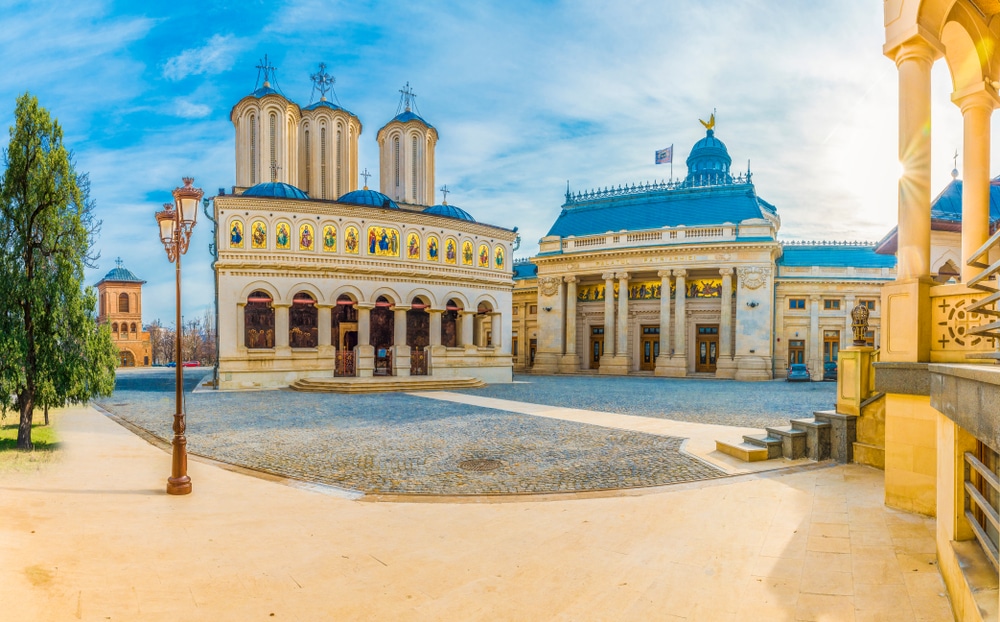 Source: Balate Dorin / Shutterstock
Source: Balate Dorin / ShutterstockThe Dealul Mitropoliei hill holds immense cultural importance in Romania as the seat of the head of the Romanian Orthodox Church, the Patriarch of All Romania.
The Patriarchal palace, dating from the end of the 17th century, is closed to the public, but warrants a look from the outside for its historical value.
Romania’s Chamber of Deputies and Great National Assembly met here long before the communist period, and then again following the Revolution, up to 1997.
At the centre of the main square atop the hill is the Romanian Patriarchal Cathedral, built in the 1650s and elevated to its current Patriarchate in 1925.
The building, essentially a replica of the early-16th century Curtea de Argeș Cathedral, has been reworked several times, most recently in the 1930s.
The nearby bell tower is from the turn of the 18th century, and served as an entrance gate to the precinct.
It was at this very spot in 1862 that the prime minister Barbu Catargiu, was assassinated, on his way to give a speech at the Chamber of Deputies.
22. Radu Vodă Monastery
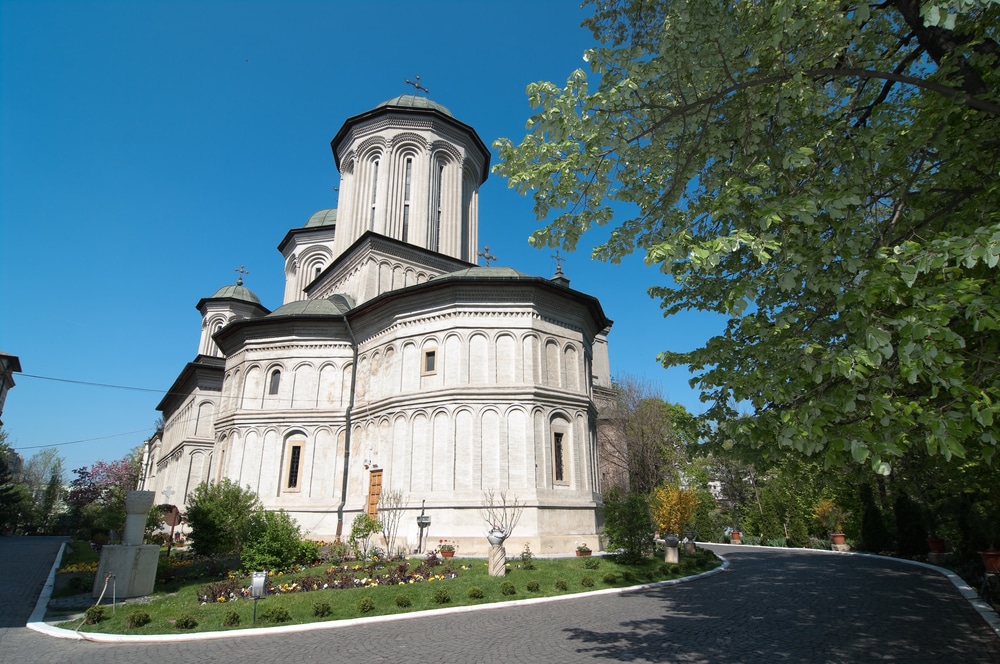 Source: ollirg / Shutterstock
Source: ollirg / ShutterstockThis hilltop monument over the Dâmboviţa riverbank is on what is thought to be the oldest inhabited site in the capital.
The remains of a Palaeolithic settlement have been found here, and this was followed by a Dacian fortification around 2,000 years ago.
The Radu Vodă Monastery was established in the 16th century under Prince of Wallachia, Alexander II Mircea.
The monastery later became the home of Bucharest’s first library, and the initial church building was reconstructed in 1625 after being burnt down by the retreating Ottoman troops of Koca Sinan Pasha.
Though the monastic structures are long gone, the 17th-century church survives, and was restored in the 19th century and again in the 1970s. Most of the frescoes inside were painted by Sofian Boghiu (1912-2002), but there’s earlier art by Gheorghe Tattarescu in the narthex.
23. Arcul de Triumf
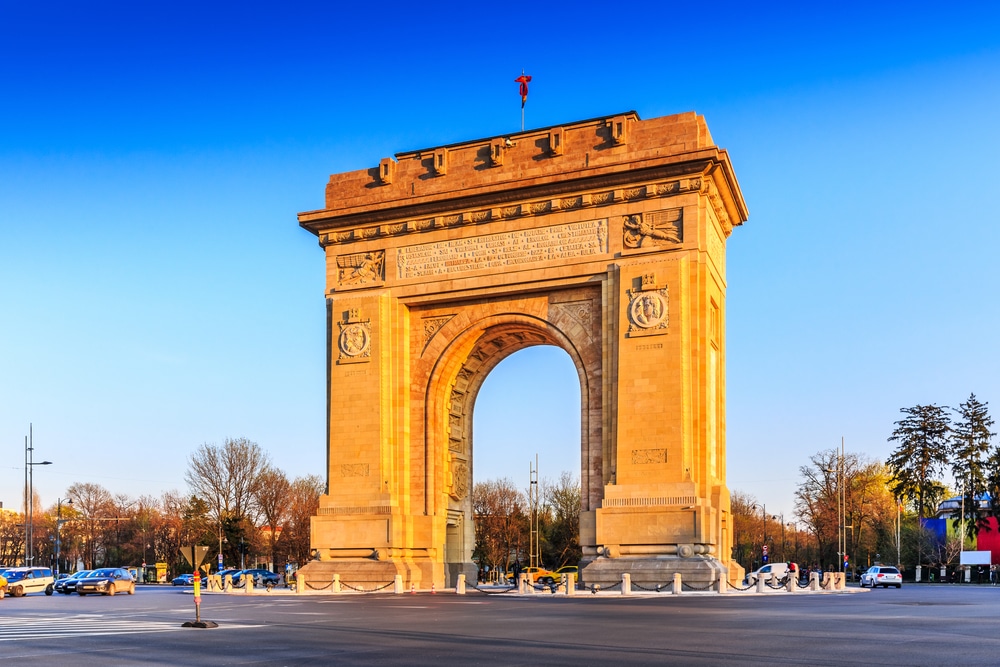 Source: emperorcosar / Shutterstock
Source: emperorcosar / ShutterstockOne of Bucharest’s postcard images is this triumphal arch north of the city centre, where Șoseaua Kiseleff intersects with three boulevards on the edge of Michael I Park.
The arch was raised in the wake of the First World War, and as a consequence of the Allied victory almost all of the European territories inhabited by Romanians were united as one state.
The monument, now 27 metres tall, reached its present form in 1936 and is carved from Rușchița marble.
If you fancy a closer look, you can peruse the inscriptions, recording the locations of key battles and celebrating victory and unification, as well as sculpted medallions, the royal coat of arms and effigies of King Ferdinand and Queen Marie.
Romania’s national holiday is December 1, marking unification in 1918 and observed with a military parade passing through the arch.
24. Bucharest Botanical Garden
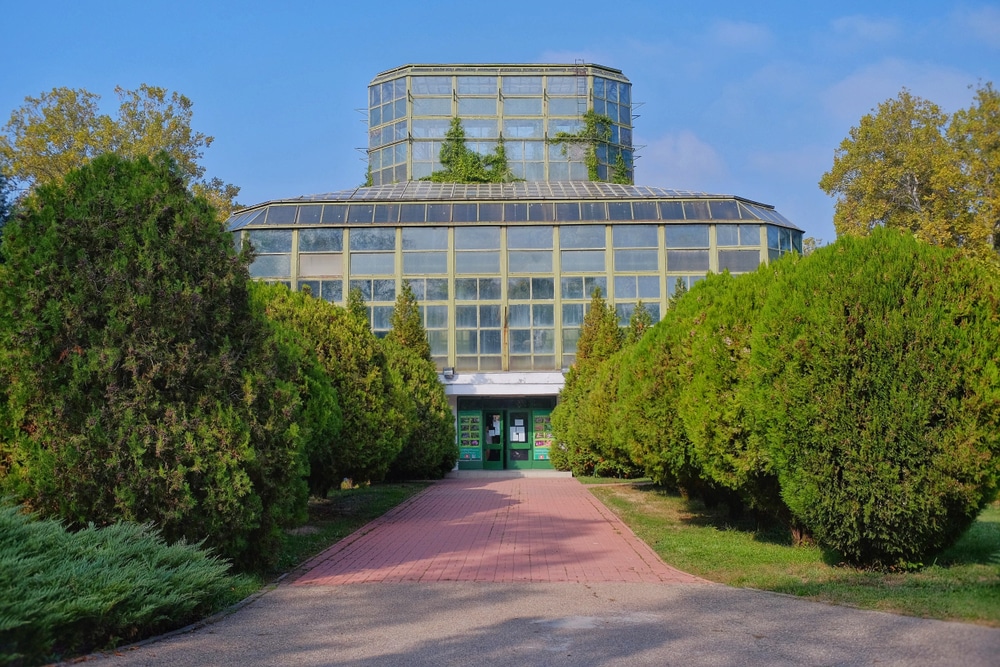 Source: vio0orel / Shutterstock
Source: vio0orel / ShutterstockThe University of Bucharest’s botanical garden was founded in 1860 and moved to its present location in 1884.
The garden had a difficult time in the first half of the 20th century, suffering damage in both world wars, but has since replenished its herbarium, which lost some 500,000 specimens during Anglo-American bombing in 1944.
Charging a small fee, the garden covers 17.5 hectares and has a series of greenhouses, including a beautiful one dating from 1891 and modelled on the conservatories at the Liège Botanical Garden.
These contain succulents, cactuses, palms, orchids and Victoria water-lilies. The garden’s museum is set by the entrance in a Brâncovenesc-style building, has plant specimens in glass jars and dioramas with animal taxidermies.
25. CEC Palace
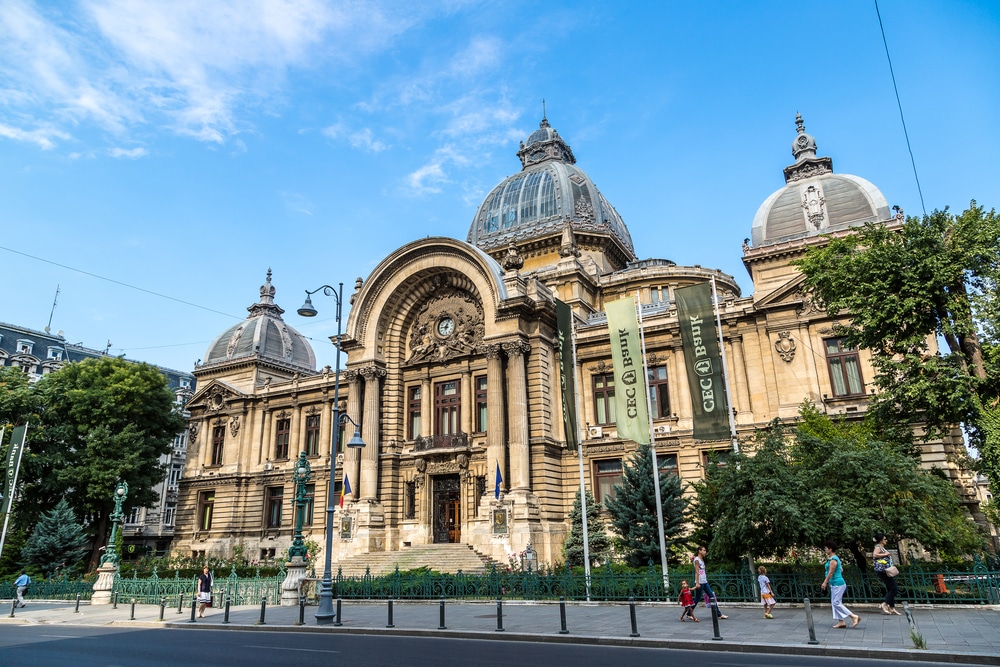 Source: S-F / Shutterstock
Source: S-F / ShutterstockOne sight to admire purely for aesthetic reasons is the Beaux-Arts headquarters of the CEC bank, opposite the National Museum of Romanian History on Calea Victoriei.
Completed in 1900, the CEC Palace was built on the ruins of a design by French architect Paul Gottereau, who also conceived the Cotroceni Palace trained at the École nationale supérieure des Beaux-Arts in Paris.
From the street you can make out the elegant metal and glass central dome, while each of the building’s four corners culminate with a smaller Renaissance dome.
The main portal is also striking for its high round arch, containing a clock and tympanum relief, and held up by two pairs of fluted columns.
In recent years, the CEC Palace has been a venue for important events, like Margareta of Romania’s 60th birthday in 2009.